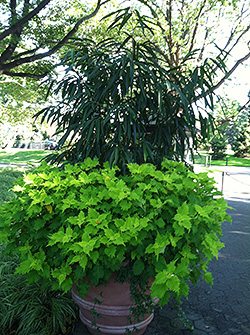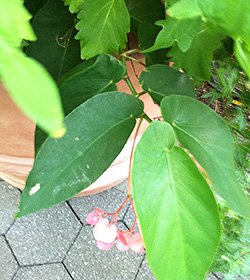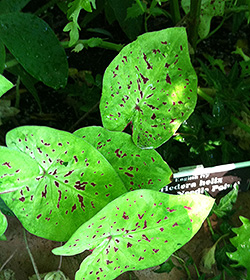Containing The Situation
Posted in Horticulture on October 28 2014, by Lansing Moore
Sonia Uyterhoeven is NYBG‘s Gardener for Public Education.
 Two large containers adorn the entrance out by Bedford Gate. Traditionally, we have used the narrow leaf fig (Ficus binnendijkii ‘Alli’) as the centerpiece for these containers. Our specimens are multi-stemmed with long, narrow, lance-shaped leaves. Ficus binnendijkii ‘Alli’ is not as fussy as the ubiquitous weeping fig, Ficus benjamina. It is more tolerant of low light levels and does not have a tendency to drop its leaves when moved.
Two large containers adorn the entrance out by Bedford Gate. Traditionally, we have used the narrow leaf fig (Ficus binnendijkii ‘Alli’) as the centerpiece for these containers. Our specimens are multi-stemmed with long, narrow, lance-shaped leaves. Ficus binnendijkii ‘Alli’ is not as fussy as the ubiquitous weeping fig, Ficus benjamina. It is more tolerant of low light levels and does not have a tendency to drop its leaves when moved.
Our Ficus binnendijkii ‘Alli’ specimens are terrific candidates to under-plant with annuals. In late spring we place the narrow leaf figs into larger pots that provide ample space for seasonal plantings.
The combination for this year’s summer display started with good intentions and then went awry. The errors that were made are common and instructive. We under-planted Ficus binnendijkii ‘Alli’ with the following: angel wings (Caladium ‘Miss Muffet’), English ivy (Hedera helix ‘Green Needle Point’), begonia (Begonia ‘Pink Giraffe’) and coleus (Solenostemon ‘Wasabi’).

On paper everything looked good. The angel wings ‘Miss Muffet’ is a dwarf cultivar that grows 12 inches tall and has small to medium arrowhead-shaped leaves that are chartreuse with red spots that bleed through the foliage.
Begonia ‘Pink Giraffe’ is a mild-mannered version of the pink dragon wing begonia. It is a tall cane type begonia with apple-green leaves and pendulous pink flowers. The foliage is luxurious and it has a nice arching demeanor.
If, as Fine Gardening magazine tells us, a good starting point for container recipes is to include “thrillers, spillers, and fillers,” then the Ficus binnendijkii ‘Alli’, the angel wings, and the begonias were the “thriller.” The English ivy (Hedera helix ‘Green Needle Point’) provided a delicate perennial accent as the ‘spiller,’ and the coleus acted as a filler.

The coleus we selected, ‘Wasabi’, has lovely chartreuse foliage. The color was perfect for the shady container. Unfortunately, this specific coleus grows 18 to 30 inches tall, and it grew as if it were on steroids. Within no time, it had engulfed the other annuals. The begonia disappeared, the angel wings were smothered, and the ivy timidly peeked out from underneath the mass of coleus.
With a coleus, you can adjust the size by pinching it back. It is good practice to pinch your coleus—it will promote branching and it will prevent the plant from flowering. Flowering channels energy away from the foliage and into the flowers, so it is undesirable to grow for foliage in an annual.
As part of general container maintenance, grooming is imperative. There is, however, an important truth in gardening—if something wants to grow, it is better to let it grow. With all the choices we have on the market days, it is much easier to select a smaller cultivar rather than trying to force a plant to do something it doesn’t want to do.
Gardening, however, is about experimentation and learning. Now we know that Solenostemon ‘Wasabi’ is terrific for a shady border that requires height, volume, and color. For a container, it is probably better to plant Solenostemon ‘Dapple Apple’ or another similar variety, which also has chartreuse foliage but only grows 10–14 inches tall.

